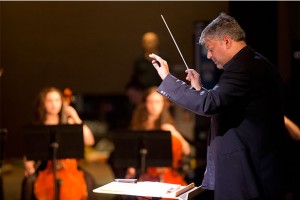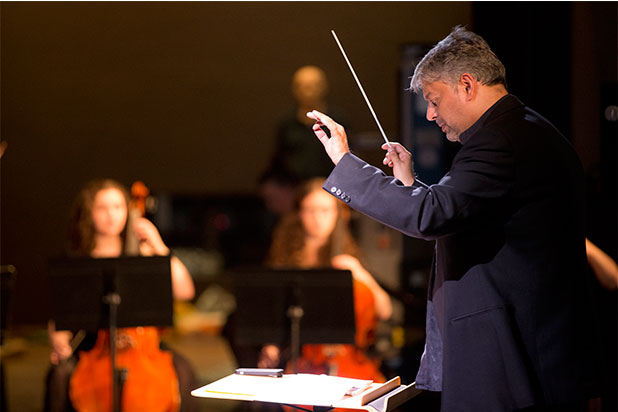Hannah Ganecki reviews the National Youth Orchestra of Great Britain at Royal Festival Hall.
Shrinking away from the surrounding darkness, the audience huddle under a cold blue light in the centre of the Clore Ballroom. Deftly capturing the menacing vacuity of Space, this was the ideal setting for a series of compositions exploring interstellar travel. Composed by members of the National Youth Orchestra, the score rocketed the audience through a fascinating and beautiful chorus of scientific debate.
The performance commenced with a violin trio that hypnotised the audience with a shrill and jaunty motif. Entranced by the haunting harmony, the audience reeled at a sudden boom that resonated from the cellos and double bass. Chaos ensued, as the melody of each instrument differed in rhythm and harmony, creating an uncomfortable clash of sounds. The polyphony climaxed with a crescendo, abruptly followed by silence. As the audience eagerly awaited the final chord progression that would tie it all together, dissonance lingered in the air. This imperfect cadence was the perfect end to a composition that described the collision of two stars: despite their magnitude, events that transpire in space rarely have a tangible impact upon our daily lives.

Composing a piece of music of this scale involved many painstaking hours, sleepless nights and a rigorous rehearsal process. NYO rehearsals consist of residencies, during which the orchestral players concentrate on existing repertoire, while the composers attend lectures on contemporary music and workshops on new writing. Under the tutelage of Anna Meredith and Larry Goves, the composers are set exercises focussed on an unusual ensemble combination, a piece of contemporary music or a theme – in this case outer space. Overnight, they prepare their composition for a rehearsal the following morning, allowing them to modify their work as it is performed by a chamber group of NYO musicians. It is under these intensive conditions, alongside young, like-minded musicians, that NYO composers create new orchestral repertoire for the 21st century.
A topic of increasing popular concern has been the effect of isolation upon astronauts. This issue was explored by the NYO with a composition that incorporated a voiceover describing the psychological consequences of space travel. Imagine living without the warmth of the sun, a cool breeze or flowing water. Imagine being confined to an aircraft, thousands of miles from your family. Imagine seeing the Earth in its entirety, a mere ball of blue and green swirls. Many astronauts suffer from a condition called “break-off”: isolation causes them to feel disconnected from the Earth – in some serious cases, detached from reality altogether. The impact of this message was enhanced by the claustrophobic setting and an emotive musical score. The musicians descended from the stage, forming an arch between the towering pillars that surrounded the audience. A violinist accompanied the voiceover with a solitary melody, and was gradually joined by the remaining violins, cellos and double bass. The texture and volume matured so subtly that the audience barely noticed the increasing minor harmony. This effect remained unnoticed until, after a climactic crescendo, all but the initial violinist fell silent. The poignant violin motif swept an overwhelming sensation of loneliness over the audience, coaxing each individual to question the significance of their life within the context of the universe.

By ingeniously integrating modern technology into their depictions of contemporary themes and events, the composing section of the NYO create important and thought-provoking performances. Their compositions break the boundaries of conventional harmony and technique, shattering the presumption that orchestral music is confined to baroque and classical conservatism.
Succeeding each rehearsal residency, the work of the NYO composing section is performed for free, in major concert halls such as Royal Festival Hall. For more information go to https://www.nyo.org.uk/summer-2016.





